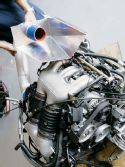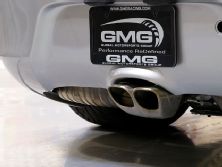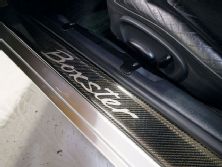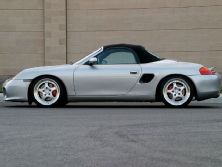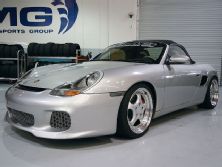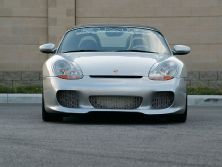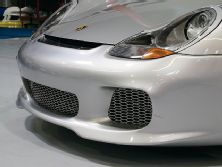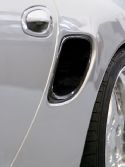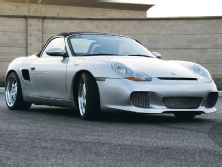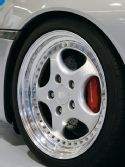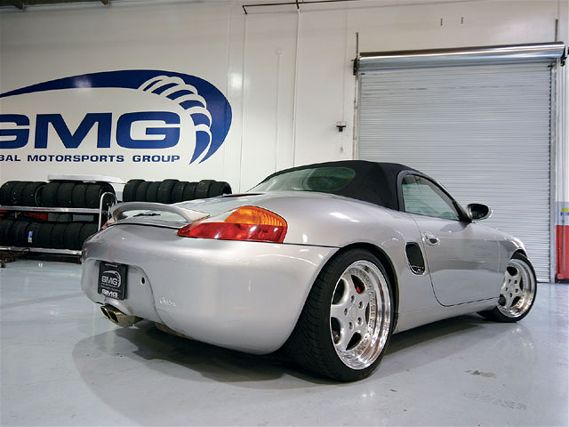 | Porsche Boxster - Project Car - 996 3.6-liter X51 Engine
| Porsche Boxster - Project Car - 996 3.6-liter X51 Engine
Many years ago, when I was but a boy, this magazine started a project that apparently has no end. Editor Bidrawn leveraged the power of family and their associated check books to 'team buy' a 1997 Porsche Boxster. The goal was to make the best Boxster in the world. Apparently there's some sibling rivalry within the Bidrawn clan. Being an editor for a car magazine, this was his chance to get something stuck on the proverbial family fridge.
It started out simply enough with some bolt-on power mods from Performance Products. A Dansk performance exhaust, a Powerflow intake and GIAC software netted almost 186 wheel-hp, which was deemed adequate at the time. Suspension was augmented with H&R coilovers that allowed for ride height adjustment and corner balancing. To scrub off speed, Brembo supplied a GT kit that increases not only stopping power but also capacity. All-day canyon running will not show any sign of fade. The giant brakes also look great, the red calipers look factory-correct, while sharp eyes will notice the bigger rotors.
Keeping with the factory-look theme, RH supplied Cup wheels for a slightly more aggressive demeanor. The polished lip has just enough shine to improve the looks while still honoring a classic Porsche design. For better aerodynamics, LL Tek in Montreal provided a Caractre body kit that uses appointments from other Porsche models and applies them to the Boxster for extra downforce, better cooling and, of course, more street presence. Wet Works Garage in Newport Beach did the install and everything was good.
That is, until someone decided more power was necessary. Bidrawn can't leave well enough alone, so a supercharger kit was sourced from Turbo Performance Center. Countless man-hours went into trying to get the kit to function properly. Engine bay was a bugbear, but the biggest problem came when the fuel mixture leaned out under boost and grenaded the engine.
The poor Boxster sat immobile for several years while a suitable fix was devised. As the old adage goes: there's no replacement for displacement. The Boxster left the factory in Finland with a 2.5-liter flat six that provided 201 hp at 6000 rpm. Considering the 911 came with 202 hp way back in 1984, it's no surprise this wasn't satisfactory. So most recently, a 996 3.6-liter X51 engine was sourced straight from Porsche for a swap.
Although this is an easier swap than say, turbine power, it's still significantly more work than swapping a Boxster S engine would have been. The largest problem stems from the fact that the 3.6 has an e-throttle; there's no mechanical link between the throttle pedal and the throttle body-it's all done electronically. The Boxster uses a standard throttle cable. The second problem was that the Boxster originally had single-cam variable valve timing, while the 3.6 utilizes timing control on both bumpsticks. All this combines with the fact that the 3.6 is substantially taller than the 2.5.
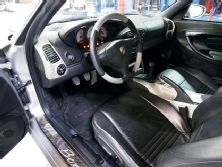 | Porsche Boxster - Project Car - 996 3.6-liter X51 Engine
| Porsche Boxster - Project Car - 996 3.6-liter X51 Engine
The crew at GMG took on the challenge of shoehorning the new engine into the older project. Custom engine and tranny mounts were fabricated so the taller intake plenum would fit inside the Boxster's cramped engine bay. Once inside, a solution for the variable valve timing had to be found. GMG used the heads from an early 3.4-liter 996 that utilized the same single-cam system, but the ports were revised to handle the added airflow. The cams were re-profiled to match that of the X51 to ensure the same performance. The new wiring harness and DME were also sourced from a 3.4-liter 996. This allowed the use of a mechanical throttle body, which simplified things greatly. A new cold-air intake system was custom fabricated and the fueling system came from the X51.
GMG decided a Cayman S exhaust would be the best option for fit and emissions. The factory catalysts are retained, keeping things simple and legal. A sport exhaust is always an option when looking to save some weight and add power.
Electronic tuning was left to GIAC. While this swap is a little out of the ordinary, it isn't that much of a stretch for the company. A custom lightweight flywheel and Sachs racing clutch were installed to handle the extra torque. There's a certain amount of doubt right now as to how long the factory transmission will hold together with the newfound power. No doubt it'll be the next mod on the list. It's still unclear whether a full performance rebuild and reinforcement will be a better route than a complete swap.
With the install complete, GMG corner-balanced the car to compensate for the new engine weight. Right now, the car idles just like factory and pulls off the line with no effort at all. The clutch is surprisingly easy to manipulate and no ill effects have been found concerning the lightweight flywheel.
This may seem like a ridiculous way to go instead of just buying a newer, faster car to begin with. If you're lucky, you can find a Boxster with a blown engine for less than 10 grand. The engine itself will be about another 10, so without labor you're still around $20,000. It gets even more expensive when thinking about the brakes, suspension, aerodynamics and so on. However, if you have a Boxster that's already modded, then the engine swap may make sense. And surprisingly, swaps like this seem to be catching on, using everything from late-model Boxster S motors to GT3 powerplants swapped into older cars.
Our editor swears the Bidrawnxster is finished. I'll believe it when I see him drive it to work. Especially when I see a tell-tale trail of transmission parts in a month or so.
Real-World Project Build Advice
* In an ideal world, a project car build would go something like this: first, decide on a project based on the car's intended purpose. For example: racecar, weekend canyon carver or even daily driver. From there, further goals can be set.
If it's a dedicated racecar, the rules of the specific class will be the guidelines. If it's going to be used strictly for open track days and driver's education events, then ease of driving, reliability and maximum enjoyment may be the focus.
For a weekend toy, canyon carving will require a suspension optimized for handling while still providing a tolerable ride on the way to and from the canyons. Power upgrades may be limited to emissions-legal modifications and aesthetics may be ignored completely.
For daily drivers, the owner may want to spend more on aesthetics than go-fast items, improving the looks while leaving mechanicals largely as they left the factory. Once a goal is set, budgeting can be put in place. In this ideal world, everything comes at a discount and nothing unforeseen ever happens.
Last, a car would be chosen. That's right, there's no point in getting a car before deciding on the above considerations. The start of the project would be a brand-new car right off the lot that didn't require any maintenance. For racing, pick the car that would have the greatest advantage in its class.
If it's a canyon carver, choose something that starts out light from the factory with a decent power-to-weight ratio and a good selection of tuning accessories already on the market. For a daily driver, you may want the latest and greatest, plus something that will meet any other special requirements.
Sadly, things don't always go perfectly. Our starting point is often determined by factors other than what the ideal car would be. We run into budget problems and can't have different cars for different pursuits.
Starting with an ideal car or not, forethought is still required before purchasing components or making any modifications. The real key to building a project car is balance. Any power gains have to be accompanied by comparable suspension and braking modifications.
A necessity for any successful project is adequate planning. Talk to people who have built cars similar to what you're planning. If it's a racecar, spend a few days at the track to see what the fast guys are running. With canyon carvers and dailies, find people in local groups who can help. Many enthusiasts have gone through several iterations of the same car trying to find the ultimate parts combination. Learn from their (often painful) experience.
When it's time to buy, talk to the various manufacturers and retailers. They can help make the right decisions on grouping products together. One suspension kit may be perfect for a street car with mild bolt-on power upgrades, but be worthless for a racecar that is 30 percent lighter and generating twice the factory power. That big brake kit may look great and be perfect for track work, but may not get enough heat into the components to make them useful on the street. The same holds true for everything from tires to spark plugs.
Before buying parts, make sure the car is in good running order to begin with, that basic maintenance is up to date and everything is in perfect operating condition. That being said, don't replace parts twice. Always check to see if a high-performance upgrade is available and, if appropriate, use it.
Also, think about a logical order for the modifications. Everyone wants to do power mods first, but if the factory clutch can't handle more power, start there. If you're doing the clutch and also plan to include a limited-slip differential, then do them at the same time to limit labor. Think about what has to be disassembled every time a part is installed and figure out if other parts you plan on replacing are involved.
Everyone wants parts at a discount or even for free. Regardless of whether you're going to build the coolest, most cutting-edge version of whatever kind of car you've chosen, a shop or manufacturer is going to need to justify any discount. Have a plan before approaching anyone for sponsorship. If it's a racecar, commit to a schedule of races and demonstrate that you're going to be more than a back marker. If possible, show evidence of past success in other classes.
The same holds true for building a show car. Outline a show schedule you'll be obligated to keep, provide examples of cars you've built in the past. If this is your first project and have nothing to show, resign yourself to probably paying retail price for everything.
Yes, almost all shop owners are enthusiasts by nature, but they're business people by necessity. It's all about the bottom line. You may be the most active user on a website and all your friends ask you what to buy, but if you can't demonstrate that, it won't matter. Giving/discounting parts or labor needs to be an investment for the business. If a place isn't guaranteed a return, sponsorship isn't going to make sense.
Last, make sure you're building the project for the right reasons. Is this a car you're going to enjoy once it's finished? Many enthusiasts have built cars and decided to sell them within a few months of completion. This isn't necessarily a bad thing, but realize that you may never get all your money back from a project car. Few people are interested in how much you spent in long-distance calls and shipping to get that South African-market spark plug wire holder no one else in this country has. Some might think it's cool, but most will only be willing to give a small fraction of what it cost.
Hopefully, this hasn't scared you from building a project car, because there's something truly satisfying about being able to finally drive your vision. Seeing something through from start to finish is always fun, but when the end product is the car of your dreams, the reward can last for years.
There are thousands of enthusiasts who regret never completing or even starting the project of their dreams. There are few who ever regret finishing one.
-Michael Febbo

